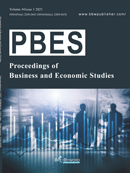Abstract
The manufacturing industry is an important pillar of the national economy. It is of vital importance to develop statistical modellings in order to quantify the relationship between potential internal drivers and the trend of output values in the manufacturing industry. However, only a few statistical modellings have been established to investigate such associations. This study developed the correlation coefficient model and generalized linear model (GLM) to measure the single and interactive effects of the internal drivers on the changes of the output values. For the GLM, different predictive variables were developed to fit into the dataset, and the performance of the models were compared using fitness parameters. Furthermore, an industry survey dataset for 1,180 manufacturing enterprises in 2020 was used to validate the models. The use of the GLM combining land area, number of employees, scientific research input, and labor productivity may have a great potential to bolster capacity in monitoring and predicting the trend of output values in the manufacture industry.
References
Garcia-Vega S, Zeng XJ, Keane J, 2020, Stock Returns Prediction Using Kernel Adaptive Filtering Within a Stock Market Interdependence Approach. Expert Systems with Applications, 160: 113668.
Hanias MP, Curtis PG, Thalassinos E, 2012, Time Series Prediction with Neural Networks for the Athens Stock Exchange Indicator. European Research Studies Journal, European Research Studies Journal, 0(2): 23-32.
Profillidis V, 2000, Econometric and Fuzzy Models for the Forecast of Demand in the Airport of Rhodes. Journal of Air Transport Management, 6(2): 95-100.
Ismail Z, Yahya A, Shabri A, 2009, Forecasting Gold Prices Using Multiple Linear Regression Method. American Journal of Applied Sciences, 6(8): 1509.
Liu L, Wang Q, Wang J, et al., 2016, A Rolling Grey Model Optimized by Particle Swarm Optimization in Economic Prediction. Computational Intelligence, 32(3): 391-419.
Hassan MR, Nath B, 2005, Proceedings of the 2005 5th International Conference on Intelligent Systems Design and Applications (ISDA’05), 2005: Stock Market Forecasting Using Hidden Markov Model: A New Approach. IEEE, : 192-196.
Madsen H, Thyregod P, 2010, Introduction to General and Generalized Linear Models, CRC Press, 32-34.
Lehman A, O’Rourke N, Hatcher L, et al., 2005, Jmp for Basic Univariate and Multivariate Statistics, 67-69.
Vehkalahti R, 2008, The Concise Encyclopedia of Statistics by Yadolah Dodge. International Statistical Review, 76(3): 460-461.
Dobson A, 2004, The Oxford Dictionary of Statistical Terms. Yadolah Dodge (ed.), Oxford University Press, Oxford, 2003. Statistics in Medicine, 23(11): 1824-1825.
Cox DR, 1984, Interaction. Revue Internationale de Statistique (International Statistical Review), 52(1): 1-24.
Wu J, Tschakert P, Klutse E, et al., 2015, Buruli Ulcer Disease and Its Association with Land Cover in Southwestern Ghana. Plos Neglected Tropical Diseases, 9(6): e0003840.
Wang P, Goggins WB, Chan EY, 2018, Associations of Salmonella Hospitalizations with Ambient Temperature, Humidity and Rainfall in Hong Kong. Environment International, 120: 223-230.
Hastie TJ, Tibshirani RJ, 1995, Generalized Additive Models for Medical Research. Statistical Methods in Medical Research, 4(3): 187-196.
Liu S, 2012, Introduction to General and Generalized Linear Models by Henrik Madsen, Poul Thyregod. International Statistical Review, 80(1): 183-184.
